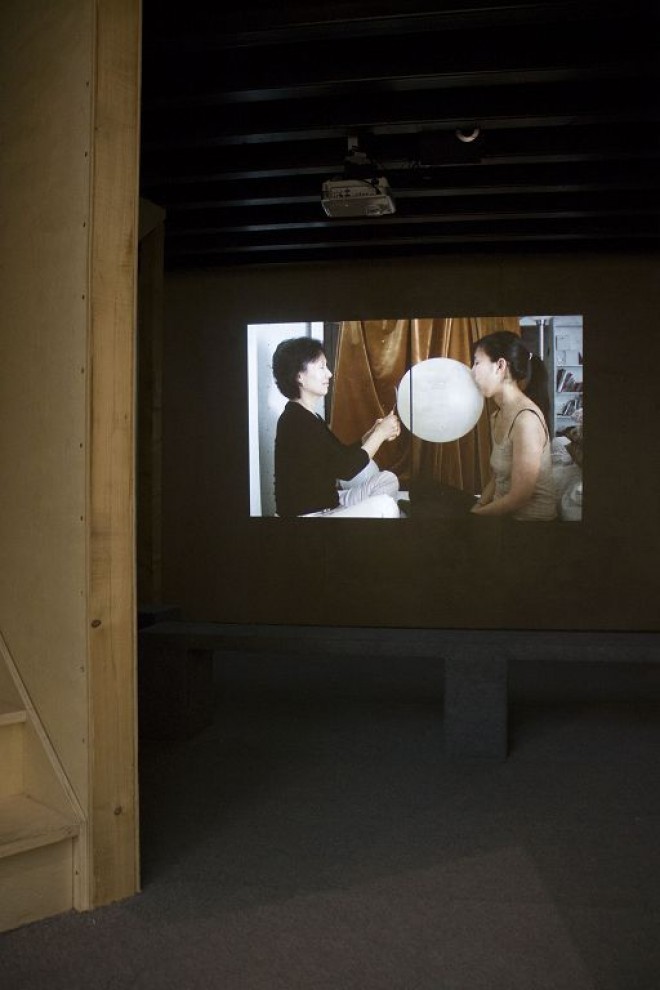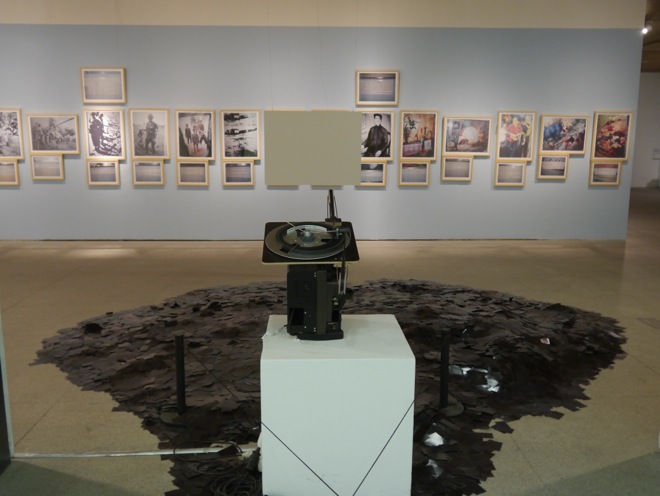The Second CAFAM Biennale: “The Invisible Hand: Curating as Gesture”
CAFA Art Museum (8 Huajidi Nan Jie, Chaoyang, Beijing 100102) Feb 28, 2014–April 20, 2014
For the second iteration of the CAFAM Biennale (Central Academy of Fine Arts Art Museum), “The Invisible Hand: Curating as Gesture” was chosen as the theme, with the focus squarely on the importance of curatorship. This show invited top graduates in curatorial studies from six art schools around the world as the curators, with faculty members in curatorial programs serving as academic advisors; the six main sections of this biennale were curated in this way. The principal points of departure for these six curators are none other than the academic topics they are interested in, as well as the academic training they have received along with any practical experience. The six curators are, respectively, Hu Danjie (Central Academy of Fine Arts, Beijing), Ma Nan (China Academy of Art, Hangzhou), Weng Xiaoyu (California College of the Arts), Angela Jerardi (de Appel arts centre, Amsterdam), Kit Hammonds (Royal College of Art, London) and Vernico Valentini (École du Magasin, Grenoble). Within such a spacious museum, six relatively independent exhibitions all staked out their own space, each with their own titles, making for a rich but disorderly “jungle” of art.
Two reasons justify calling this being called a “jungle”. The first is the exhibition’s spatial experience as presented to viewers. Many video works were selected this time, especially in “The Code of the Golden Bough—Economics of Witchcraft, Soul, and Faces” and “No Puppet is Dumber than Its Puppeteer”; located on the second floor, both present above-average video works in a dense and expansive array. At the same time, exhibition halls which were originally bright and airy are consequently divided up into so many “black rooms” in which videos are projected. The windy, meandering corridors are thus imbued with a gloomy, secretive air akin to shadowy lairs in darkening jungles.

《没有木偶比操纵者更愚蠢》展览现场
Another reason to call this a “jungle” is the way in which the exhibited works and the six sub-exhibitions themselves all present a wealth of perspectives as well as their own uneven levels of quality; one is reminded of the expression “to each his own”. The exhibition ascends from the shameful trajectory set out on the second floor to the “Curatorial Genealogy” on the fourth floor, where the development of curatorship is mapped out clearly; one could say things improved as one went up. In terms of the choice of works, what stood out were the video pieces and open, interactive activities in this exhibition.
As performance art and video have always constituted a minority in contemporary art in China, the exhibition’s focus and promotion of these forms to a certain degree opens up the perspectives of domestic viewers and their experience and understanding of the full wealth of visual language. (This writer can happily report female art students lazily lying on the carpets of the screening room, finishing the entire video in a leisurely manner. One can but be gratified by such nonchalance and self-confidence.) Furthermore, the exhibition format of integrating video art together with installations, as well as the overall setting and the architecture, lends the exhibition space a rare delight and novelty in addition to the actual viewing experience. Take Pauline Boudry/Renate Lorenz’s “Salomania”, for instance—a work that offers depth and is worth referencing: the camel-hair palm tree backdrop with its intense theatricality and orientalism is rendered as a symbolic form and placed outside in the exhibition hall as one part of the work (see image). Or “Two Storey Tower for Two Stories”, created via a collaboration between Korean artist Yva Jung and the architect Thomas Goodey, with the placement of the two video works in the floors of the wooden structure, forges a fresh dialogue between the content of the work and the site-specific space. In one video located on one floor, for example, the artist and her mother are shown sitting apart on a bed, holding an inflating balloon and a spoon, respectively; mutual calm, reticence and subtle tension resonates with the reclusive space within the wooden structure. On the next floor, the performance piece with the balloon, the wilderness, and the body (depicting the artist alone on the snowy Arctic landscape) is projected on two intersecting and vertically-balanced walls. This fully makes use of the walls within the wooden structure and furthermore adds a distinctive visual effect (regardless of whatever room for improvement exists in such combinations)(see image).
Another strong suit in this show is the choice of certain projects which highlight interactivity and audience participation. Luke Ching’s “Public Monument: Safety Man”, for example, calls on the audience to write down the name of an unknown or uncelebrated hero (see image). Meanwhile, the “Game Theory” section on the third floor is set up almost like some kind of board game; with its low threshold and entertaining technique, the exhibition space becomes a playground for young as well as older, grown-up children with a spirit of participation. Though the rules of the games can get a bit repetitive, the aim was mainly to grant the audience a new identity or point of view through the throwing of a dice, the drawing of lots, and so on. For the vast majority of viewers in China, this is still rather interesting and unusual.

郑伊娃,《两个故事的双层塔》,展览现场(摄影:刘一)。
Aside from the art works, however, another point worth noticing in this edition of the CAFAM Biennale is the ways in which the six curators managed, through their respective curatorial practices, the relationship between curatorial concept, theme, artworks and space. Perusing the six curators’ starkly different explications, you will find in particular Hu Danjie and Ma Nantwo representatives of young Chinese curating. While the former tends toward a rather more academic style of narration through the citation of abstract concepts and terms, the latter piles up rather general and loose lexicons in a brief but poetic explanation. This is in direct contrast with the decidedly clearer statements by the other four curators. This writer believes that one can detect the two major branches of intellectualizing “curatorialese” within current Chinese curatorship. One is to use recondite terms and academic theories to complicate something simple—through various reasons and an array of concepts, it will appear all-embracing and faultless, but actually finds it hard to stay grounded and resolve questions in earnest. Another tendency in contrast is to employ essayistic personalized impressions, full of free but hazy emotions, which makes it hard for viewers to keep up. In the face of such statements which are unable to explain themselves, the mystified viewers—aside from denigrating themselves (as “philistines”)—are left only with their powers of imagination in the struggle to fathom some logical framework in the works exhibited.
This in fact reflects a critical flaw, which is the struggle between such intellectualizing on one hand and curating as a stance or position on the other. Academic intellectualizing frequently appears authoritative, but in actual fact, it has its own limitations and a relatively narrow stance. Curators should certainly attain a certain academic level, but superb scholars do not necessarily make outstanding curators. Meanwhile, one can ask if the professors, schools and museums responsible for providing curatorial education and specialized training possess as a matter of course the greatest authority in deciding the standards of curation. Are the seemingly novel or arcane academic terms deployed to help us observe more lucidly, or do they end up befuddling everyone (including themselves) and merely proclaim a vaunted authority? Reading the curatorial theme which is everywhere and yet lacks a point of convergence, and then seeing the new terms “transcending experience, curation, and translation” (chaojingyan, chaocezhan, chaofanyi) emanating from the series of “Super-Body” (chaoshengti), “Super-Machine” (chaojiqi), “Super-City” (chaochengshi) in the first CAFAM Biennale (“Super-Organism: Research and Experiment from a Specific View”), and finally glancing at the English translation “The Invisible Hand: Curating as Gesture” [note: in the Chinese version, it is “stance” or “standpoint”; “lichang”]:—this writer cannot help but sigh. The elegance in the “gesture” of this year’s biennale, one fears, is in the end much ado about nothing, barely touching on the essence of the solid, thoughtful and yet complex idea of “stance”.

加布里埃尔·莱斯特,《梦游》,装置,2014

汉斯-彼得 费尔德曼,《一个故事》、《大卫头像》,《绘画中的女性座像》,《维纳斯》

马大哈,《时间之存在皆自马大哈的一念之间》,装置,综合材料,尺寸不定, 2013